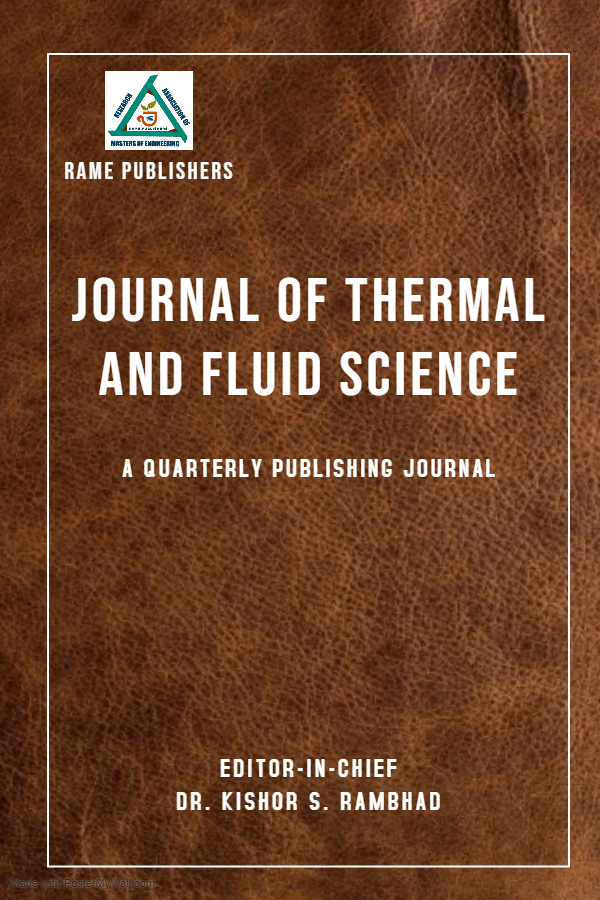Design and Fabrication of Solar Powered Sea Water Desalination System
Sagar Patil, Arfat Fakih, Shwetang Patil, Varun Patil, Harsh Kini
Journal of Thermal and Fluid Science
volume 5: Issue 1, Jan-June 2024, pp 20-24
Author's Information
Sagar Patil1, Arfat Fakih2
Corresponding Author
1Department of Mechanical Engineering, St. John College of Engineering & Management, Palghar, India
sagarrp@sjcem.edu.in, arfatfakih10@gmail.com
Shwetang Patil3, Varun Patil4, Harsh Kini5
Department of Mechanical Engineering, St. John College of Engineering & Management, Palghar, India
Abstract:-
The proposed system combines solar energy collecting and desalination techniques to efficiently remove salts and contaminants from saltwater. Solar collectors for energy capture, a heat exchanger system for thermal energy transfer, and a multistage distillation unit for water purification are all essential components. The system works on the principle of evaporation and condensation, using solar heat to vaporize seawater and then condensing the vapour into freshwater. During the design phase, system efficiency, scalability, and durability were prioritized. Advanced modelling approaches were used to optimize the system's performance under different environmental circumstances. In addition, material selection was based on durability and corrosion resistance to assure the system's longevity and reliability. The fabrication process included component assembly utilizing normal engineering standards, as well as the use of quality control procedures to ensure operating efficiency. Prototype testing was used to confirm the system's functionality and performance measures, such as water production rate, energy efficiency, and salt rejection rate. The findings show that the solar sea water desalination system is both feasible and effective in producing high-quality freshwater from seawater using renewable sun energy. The technique provides a sustainable alternative to existing desalination processes, with the potential for widespread implementation in coastal locations experiencing water scarcity. Future research directions could include greater optimization of system components, cost-cutting methods, and scalability for large-scale deployment.Index Terms:-
Water Desalination; Solar Panel; PurifierREFERENCES
- Gowtham M., et al. (2012). Performance comparison of solar concentrated distillers with latent heat storage and trays. Renewable Energy, 47, 154-159.
- Ozuomba J.O. et al. (2012). Fabrication and testing of a roof-type solar water distillation kit. Renewable and Sustainable Energy Reviews, 3141-3147.
- Caroline S.E. Sardella (2012). Analysis of water production rate and quality in solar distillation systems. Desalination, 287, 85-92.
- Prof. Alpesh Mehta et al. (2011). Experimental study on solar distillation for brackish water purification. International Journal of Sustainable Energy, 1-12.
- Zhang, Y. (2019). Numerical simulation of solar powered multi-effect distillation desalination systems. Desalination, 460, 92-102.
- Phalak, M., Kurkure, P., Bhangale, N., Deshmukh, V., & Patil, V. (2017). Fabrication of low-cost ceramic water filter for bacterial removal. Journal of Environmental Chemical Engineering, 5447-5453.
- M. Z. H. Khan, M. R. Al-Mamun, S. C. Majumder, and M. Kamruzzaman (2015). Removal of iron from water using banana residue ash. Journal of Environmental Management, 162, 26-32.
- Smith, et al. (2018). Design and fabrication of a solar-powered reverse osmosis desalination system. Journal of Renewable Energy, 126, 511-518.
- Aayush Kaushal et al. (2010). Methods for desalination of brackish water using solar stills. Desalination, 253(1-3), 114-121
- Kalbande VP, Walke PV, Rambhad K. Performance of oil-based thermal storage system with parabolic trough solar collector using Al2O3 and soybean oil nanofluid. Int J Energy Res. 2021; 45: 15338–15359. https://doi.org/10.1002/er.6808
- VP Kalbande, PV Walke, K Rambhad, Y Nandanwar, M Mohan, Performance evaluation of energy storage system coupled with flat plate solar collector using hybrid nanofluid of CuO+ Al2O3/water, , Journal of Physics: Conference Series 1913 (1), 012067
- KS Rambhad, PV Walke, ,Regeneration of composite desiccant dehumidifier by parabolic trough solar collector: an experimental investigation, Materials Today: Proceedings 5 (11), 24358-24366
- YN Nandanwar, VP Kalbande, M Mohan, K Rambhad, PV Walke, ,An approach toward higher electrical conversion efficiency of solar photovoltaic module using phase change materials, Energy Storage 4 (6), e379
- , K S Rambhad Pramod V. Walke, Pranav C. Phadke, Performance evaluation of forced convection desiccant bed solar dryer integrated with sensible heat storage material, International Journal of Analytical, Experimental and Finite Element analysis, Volume 5: Issue 2, June 2018, pp 24-35
- KS Rambhad, PV Walke, An experimental investigation of solar assisted air heating for solid desiccant regeneration using parabolic trough solar concentrator, Int. J. Anal. Exp. Finite Elem. Anal 4 (3), 45-47.
- VP Kalbande, KS Rambhad, PV Walke, Performance of Solar Collector for Thermal Storage System Using Nanofluids: A Review, International Journal of Analytical, Experimental and Finite Element analysis 2 (1), 6-11.
To view full paper, Download here
To View Full Paper
For authors
Author's guidelines Publication Ethics Publication Policies Artical Processing Charges Call for paper Frequently Asked Questions(FAQS) View All Volumes and IssuesPublishing with




